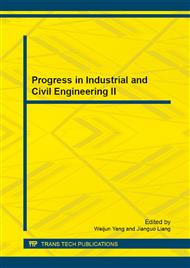p.521
p.527
p.535
p.541
p.548
p.554
p.558
p.562
p.566
The Tests on the Lime-Treated Expansive Soils Compaction Characteristics
Abstract:
The compaction characteristics of the lime-treated expansive soils from the planning airport in China's Ankang were studied through the heavy compaction tests. The results show that all these elements such as lime content, water content, soil height, wetting time have a certain effect on dry density. As the lime quality ratio increases, the optimum water content under heavy compacting standard of improved soils increases but the maximum dry density decreases. With the increase of lime content, the effect of water content on dry density decreases while the water content near to its optimum value. Soils with the lower height have higher dry density when compaction energy, lime content and water content unchanged. As the wetting time increases, the maximum dry density shows a decreasing tendency until after 48 h it remained stable. It indicates that with the same lime content the order of primary factors influence on dry density are water content, wetting time, soil height. Finally, the lime stabilizing principle to expansive soil is explained through by applying scanning electron microscope technique.
Info:
Periodical:
Pages:
548-553
Citation:
Online since:
September 2013
Authors:
Price:
Сopyright:
© 2013 Trans Tech Publications Ltd. All Rights Reserved
Share:
Citation:


